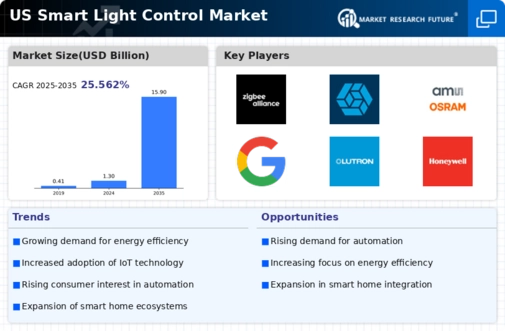Growing Demand for Automation
The smart light-control market is experiencing a notable surge in demand for automation solutions. As consumers increasingly seek convenience and efficiency, automated lighting systems are becoming a preferred choice. This trend is particularly evident in residential settings, where smart lighting can be programmed to adjust based on occupancy or time of day. According to recent data, the automation segment is projected to account for approximately 35% of the overall market by 2026. This growing inclination towards automation not only enhances user experience but also contributes to energy savings, thereby aligning with the broader objectives of the smart light-control market.
Increased Focus on Sustainability
Sustainability has emerged as a critical driver for the smart light-control market. With growing awareness of environmental issues, consumers and businesses alike are prioritizing energy-efficient lighting solutions. Smart lighting systems, which can significantly reduce energy consumption, are increasingly being adopted as part of broader sustainability initiatives. Recent studies suggest that implementing smart lighting can lead to energy savings of up to 50%. This focus on sustainability not only meets consumer demand but also aligns with regulatory frameworks aimed at reducing carbon footprints, thereby reinforcing the relevance of the smart light-control market.
Consumer Preference for Customization
Customization is becoming a key driver in the smart light-control market. Consumers are increasingly seeking personalized lighting experiences that cater to their specific needs and preferences. This trend is evident in the growing popularity of smart bulbs and fixtures that can be controlled via mobile applications. Market data indicates that customizable lighting solutions are projected to capture around 40% of the market share by 2027. This shift towards personalization not only enhances user satisfaction but also fosters greater engagement with smart lighting technologies, further solidifying the position of the smart light-control market.
Rising Urbanization and Smart City Initiatives
Urbanization is a significant factor influencing the smart light-control market. As cities expand, the need for efficient and intelligent lighting solutions becomes paramount. Smart city initiatives are increasingly incorporating advanced lighting systems to enhance public safety and reduce energy costs. For example, cities that have implemented smart street lighting have reported reductions in energy usage by as much as 30%. This trend is expected to continue, with urban areas increasingly investing in smart infrastructure, thereby propelling the growth of the smart light-control market.
Technological Advancements in Lighting Solutions
Technological innovations are playing a pivotal role in shaping the smart light-control market. The introduction of advanced LED technologies, coupled with sophisticated control systems, has revolutionized how lighting is managed. For instance, the integration of sensors and smart devices allows for real-time adjustments based on environmental conditions. This evolution is expected to drive market growth, with projections indicating a compound annual growth rate (CAGR) of 20% over the next five years. Such advancements not only improve functionality but also enhance the overall appeal of smart lighting solutions within the smart light-control market.





















Leave a Comment